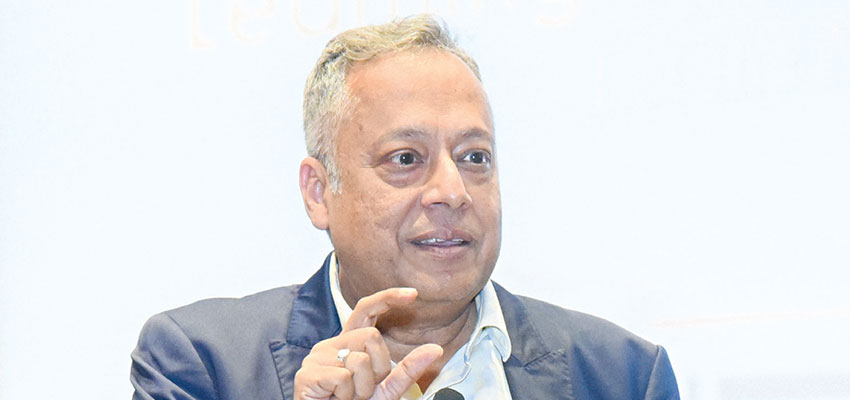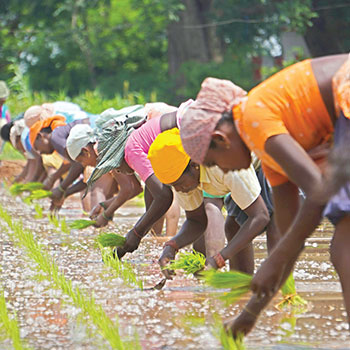Driving solutions through Sustainable Leadership

Rajiv Mitra, CEO and Director, Prabhat Dairy, part of world’s largest dairy company, Lactalis, has a vast experience of around 30 years in the corporate world out of which 20 years is in telecommunications and 10 years in dairy industries. He is a commentator on social and economic affairs, member and office bearer at several industry bodies, on advisory boards of post-graduate institutions, MSMEs and start-up companies and a keen mentor to students and professionals. Corporate Citizen brings to you the excerpts of his inspirational lecture recently held in a bschool in Pune on the theme “Learnings from Corporate Leaders”
Global food scenario
What problems we are facing in the food industry? First, I will tell about my journey. Whatever we may do and wherever we are, a big thanks to the farmers. Thanks to the farmers we eat better. Living in the cities, we are not exposed to the farmers on a daily basis. We live in the midst of a concrete jungle. But, whatever you do and wherever you are, be sure that there is farming community, be it a dairy farmer or a wheat or rice grower or poultry farmer or be it anybody. Because of them we eat better.
Just think, because of the farmers, we see less wars. Otherwise we would have seen more enmity amongst countries, people and communities, which thanks to farmers, is not there.
In the last 60 years, the world’s population has grown from 3 billion to 7.8 billion now, which is a growth of over 2.6 times. In the same 60 years, production of wheat has grown 3.4 times, rice has grown 3.5 times, corn 5.7 times, vegetables 5.8 times, fresh fruits 4.4 times, milk has grown same as population growth at 2.6 times. This shows that in last 60 years we have done well. We have done alright in terms of growth in food grains. Thanks to the farmers, we eat better. In last 60 years, we have done a good performance in most of the sectors and in most of the categories in food. We have been able to keep pace with population growth.
Challenges till 2050
Now what is the problem? The percentage of arable land on Earth is not growing because land does not grow. Land surface is not growing. Percentage of arable land is reducing due to the pressure of urbanisation. In next 20 years we need to increase our agricultural production by 70 per cent, to feed everyone correctly and properly by 2050. In last 60 years we have done well and kept pace with the population growth. In the next 20 years, it will be a challenge because land is not growing but population is growing rapidly. Therefore, we need to increase our agricultural produce by 70 per cent to feed the global population properly by 2050.
"Hiring has to be done for who and not for what—selling a product. Tomorrow when market changes, when economy changes, when governments change, regulations change, the same people can be useful in a different business environment. This is how great companies work"
-Rajiv Mitra

When we talk of sustainability, having food safety and food security will be a challenge in the next 20 years. This is not an imaginary problem, it is a real problem. So, agricultural produce will have to increase by 70 per cent, be it wheat, vegetables, corn, meat or dairy. How will it happen? The percentage of arable land at best is fixed and not growing, and at worst is reducing.
I am just introducing a problem to you and I am not here today to give solution to you. The solution will be what you come up with in your two-year MBA course and thereafter in your job and career. Whether or not you work directly for the food industry, you will be linked to the food industry either as a producer or as a consumer or somewhere in between. You may not be a part of this industry. You may not be a rice producing farmer or a rice processor or a milk processor or a seller. But, either you are a producer or you are a consumer or something in between—you cannot escape that.
In country wise percentage of arable land, India is slightly better. India has got less urbanisation than many other countries, so India is slightly better. But, our dependence on agriculture is still much more. But, within India, if you see the state wise percentage then you will find stark difference from Delhi to Maharashtra to some other state.
In last 60 years we have done well but in next 20 years we have to increase food production by 70 per cent to feed the world population properly as we are doing today.
Sustainability
What is sustainability? Sustainability is preparing for the next generation without harming and reducing consumption in the present. There will be a carbon footprint that I will leave behind if I have to go to Delhi. But, if anything has to be done then it has to be done—whatever has to be done today, I will be doing it today. Yet, I will provide and create for the future generation by increasing agricultural productivity by 70 per cent. I will do this through sustainable practices. This you will hear very often in your MBA classes, career and in your life.
Sustainability in dairy
India is the largest producer of milk in the world. It produces 220 million metric tonnes of milk per year, which is approximately 50 crore litres of milk every day. India has the largest cattle population. A cow in Australia or France gives 20 or 30 litres or even 50 litres of milk per day whereas a cow in India gives 5 litres of milk per day. This means the animal productivity in India is very low. It is one-tenth of the productivity of the French or Australian cow. Cow weighs the same as one tonne in India and other countries and generates methane which is a greenhouse gas. But, the amount of methane gas generated per litre of milk is more in an Indian cow as compared to a French or Australian cow. The biggest facilitator of carbon neutrality is productivity. The more productive you are; the less harm you are causing to society and the more sustainable you are.
Productivity and sustainability problem
Whatever you are doing as a student, be productive, that is the most sustainable way to live. Sustainability is creating for future generation. If your parents were not worried about you then you wouldn’t have been sitting here. It’s not about being worried. It’s about creating a better world to live in for ourselves and the future generation. Every hour you spend, make that hour productive.
Five levels of leadership

You need to be productive. You need to be great. If I ask the 900 to 1,000 students present here whether you are good, most of you will raise your hands. How many of you are great? There will be a few of you. Why? We are not great because we are good—most of the time we are not great because we are good.
Jim Collins has written a book ‘Good to Great’. Freshers, don’t start reading it immediately. It’s not a very easy read. Spend some more time in the campus and maybe next year start reading it. Now go and just get hold of it, feel it. It has an interesting concept. Good is the enemy of great. That is where the journey stops to be great. Why should I worry for the next generation? I am very good enough. But to be great, you must create a sustainable world. So this level-5 leadership talks about a journey from good to be great.
You are 900 highly capable individuals that is why you are here—you are capable. You have done well in your examinations and interviews. You have good leverage. You have taken care of your pets. You have cared for your neighbours, parents, brothers and sisters. You have a set of values. You are honest boys and girls. You are hardworking. You are attentive this afternoon. This means you are a capable individual. This is first level. You have to be a capable individual.
From here you become a contributing team player. You become a team. You get together as a team in your workplaces, in your projects, in school and become a contributing team player. So capable individuals and contributing team players form a pyramid. All capable individuals don’t become good team players. But all good team players are capable individuals. This is a lucky pyramid.
Third is, you are managing a team. You are not just contributing as a team but you are managing a team. You are a capable and efficient manager. An efficient manager is somebody who chases pre-set goals and has a goal to set.
So capable individual is level-1, contributing team player is level-2, and capable and efficient manager who chases pre-set goals is level-3. Level-4 is an inspiring leader. If the goals are pre-set, then somebody has set the goals. The leader who inspires, catalyses and brings out the best, has set the goals.
Q&A SESSION
Q) What is the use of analytics other than gathering information and data? What are main tools that companies are using for data analytics?
Data analytics by itself is of no use unless it helps in decision making. Any data that comes to me should be able to give me few alternatives to solve the problem, based on this data then I decide which way to go. My company and many such global companies know two things – God and Data. We don’t take decisions without data. In today’s day and age, analytics is very important. Tableau and many other tools are used for doing analytics by companies.
Q) What do you think of synthetic milk? Is it possible that synthetic milk industry will take over regular milk industry in future because we know many people are lactose intolerant so they prefer synthetic milk?
Research says that 60 per cent of Indians are lactose intolerant. It is possible to make lactose free milk which is not synthetic. According to me, it is not unfair competition. We drink milk because we get nutrition from it. If something else comes and gives us the same then I should take it as competition and it is a fair competition. So when I compete with something, I compete with a concept. If somebody wants plant based milk, then it is my job to compete with them even if there is a small market.
Q) When did you find your ‘who’ in your life? Was it on time or late?
You find it every day. This is something you evolve every day. If I have done a good job today, then I have found my who. It is not that when did you find your who. It is about finding it every day. It is about doing something worthwhile meaningful, something new and doing better than what you did yesterday.
"If I have done a good job today, then I have found my who. It is not that when did you find your who. It is about finding it every day. It is about doing something worthwhile meaningful, something new and doing better than what you did yesterday"

So from a capable individual, I have traced the journey of good to great, upto an inspiring leader. What can be there after this? This journey from level-4 to level-5 is the journey of good to great. So if level-4 is an inspiring leader, a company led by an inspiring leader is a goal. So what is level-5? This is what Jim Collins defines as an executive. Level-5 is an executive. It is a combination of humility and determination. So, this is more than an inspiration.
US President Abraham Lincoln when he says, “I may walk slow”, it is humility. Arguably America’s most important reformer Lincoln said, “I may walk slowly, but I never walk backwards.” Here ‘I may walk slowly’ shows humility while ‘but I never walk backwards’ shows the determination. Here there is humility and determination, which is level five.
Your two years MBA programme will go very fast—you will go for placement in a couple of years’ time. Jim Collins talks about first 'who' and then 'what'? First is the Person and then is the Role that we have to play. But what we do, before anything else, we start asking about the salary package. It is good but to be great, it is 'who' that matters and then 'what', because that 'what' will change, it will not remain the same tomorrow. But 'who' will remain the same.
Hiring has to be done for 'who' and not for 'what'—selling a product. Tomorrow when market changes, when economy changes, when governments change, regulations change, the same people can be useful in a different business environment. This is how great companies work.
I started my career in IT, then moved to telecom and in last 10 years, I am in agriculture and food sector. I am a city person. The smallest place that I ever lived in is Pune city. So, how do you make this change when you are, for who you are and not for what you are doing? So first 'who' and then 'what'.
When I was young, there was this popular movie Sholay, in which a jailor’s hands are cut by a dreaded dacoit, Gabbar Singh, of Chambal valley. The jailor goes on to hire two crooks (thieves) just released out of the jail, to nab this dacoit. One of the thieves asks, "What is the job?". This is a level-4 question. The jailor answers, "Bahadur ho to iski fikar kyo karte ho" (If you are brave why worry about the job), and adds, "Kam jo mai chahu, Kimat jo tum chaho" (Work that I want and price that you want).
You are worried about your first salary, your initial break—it is a good worry. What is a great worry? Are you worthy of making it very big in this lifetime, is a great worry. A good worry is - Who are the people coming to the campus? What is our corporate relations team doing? What is your starting salary? I saw in yesterday’s newspaper that a person from Pune got a Rs 50 lakh per annum package, so what will be my salary. These are good worries to have. But, great worry is how productive each day is? That's when you will see a exponential growth in your life for every five years—only if you fill in your 'who' and 'value'. ‘What’ is a good worry. The 'who' is a great worry.